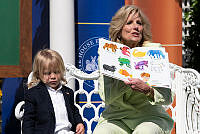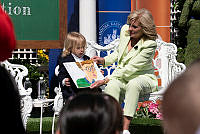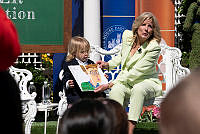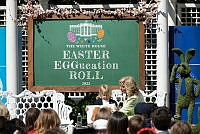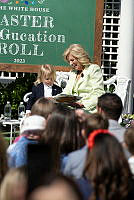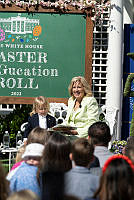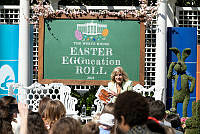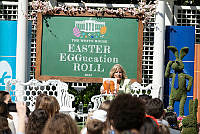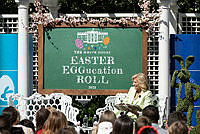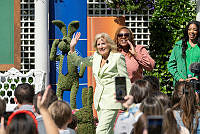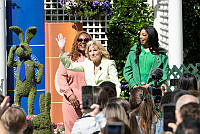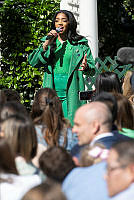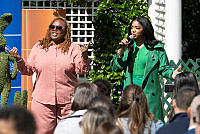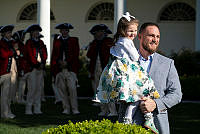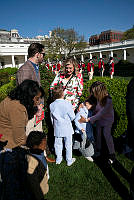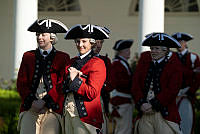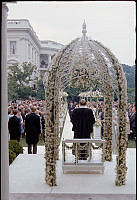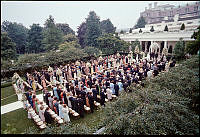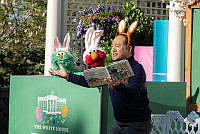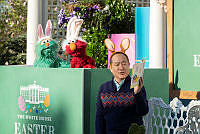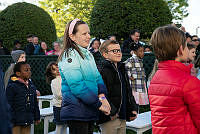Rubenstein Center Scholarship
Lady Bird Johnson's Floral Legacy
"Where Flowers Bloom, There Blooms Hope"

First Lady Claudia Johnson outside the White House, 1967.
Lyndon B. Johnson Presidential Library and Museum/NARAFew first ladies have been so attuned to the natural beauty inside and outside the White House as First Lady Claudia Johnson, or “Lady Bird.” Famed for her environmental work, she brought a sense of the floral to everything she did, from wide-ranging legislation to small touches of hospitality.
Mrs. Johnson’s White House entertaining style often included an homage to the natural world. For instance, in June 1964 the Johnsons were the first presidential couple to hold a State Dinner in the Rose Garden. At White House parties she was famous for her Flowerpot Sundaes, in which she layered ice cream, sponge cake, and meringue in a terra-cotta flowerpot with a rose or tulip stem “planted” in the middle. She chose a china pattern for the White House that was both patriotic and botanical: first ladies for fifty years before her had selected dinner plates with simple borders and an American eagle in the middle, where she wreathed the eagle in wildflowers.1

The Johnson’s White House china features a different state flower on each dessert plate. Shown here is the Texas blue bonnet.
White House Historical AssociationThough she had always appreciated natural beauty in daily life, it was in the first year of her husband’s presidency that Mrs. Johnson realized her voice could go towards helping to preserving nature on a large scale. She traced the inspiration for her involvement in beautification to President Lyndon B. Johnson’s January 1965 State of the Union address, where he said, “We must make a massive effort to save the countryside and to establish—as a green legacy for tomorrow—more large and small parks, more seashores and open spaces than have been created during any other period in our national history.” This vision began to take concrete form at one of Mrs. Johnson’s monthly Women Doer’s Luncheons, where she heard activist Mary Lasker propose a beautification program for the nation’s cities: large-scale plantings, lights, waterworks, and “masses of flowers where the masses pass.”2

Mrs. Johnson planting pansies with members of the Beautification Committee.
Lyndon B. Johnson Presidential Library and Museum/NARALasker wanted to make beautification a nationwide effort, but Mrs. Johnson wanted to start small by planting flowers in the town she lived in, Washington, D.C., and thus encourage other Americans to involve themselves in conservation as well. She reminisced later that the beautification effort began “with the hope that it would have a ripple effect across the land. Everybody who did it loves his hometown. You just say hometown and you get a smile, at least from a whole lot of Americans.” The First Lady’s Committee for a More Beautiful Capital met for the first time in the Red Room of the White House on February 11, 1965.3

First Lady Lady Bird Johnson with members of the Beautification Committee, Secretary of the Interior Stewart Udall and Laurance Rockefeller, at a Beautification Luncheon in the State Dining Room, April 27, 1967.
Lyndon B. Johnson Presidential Library and Museum/NARAThe Beautification Committee convened monthly. It began planting on Pennsylvania Avenue, then expanded outward, establishing azalea and daffodil beds by the Potomac River and in the medians and triangles of the capital city. First Lady Lady Bird Johnson would leave the White House early in the mornings in a minibus, bound for plantings all over Washington, D.C. Over the course of four years the committee planted a shocking two million daffodil bulbs, reportedly the largest planting in history. The president chuckled about the constant plant-related busyness in the Executive Mansion: “Whenever I try to take a nap, there is Lady Bird in the next room with Laurance Rockefeller and eighty ladies talking about the daffodils on Pennsylvania Avenue.”4

Signing the Highway Beautification Act in the East Room, October 22, 1965.
Lyndon B. Johnson Presidential Library and Museum/NARANot all of First Lady Johnson’s plantings last to the present day, but the spirit behind them does. Perhaps Mrs. Johnson’s most far-reaching conservation effort was sponsoring the Highway Beautification Act of 1965. “Lady Bird’s Bill” established air quality standards, provided for the building of scenic overlooks and rest stops, and set limits on unsightly billboards, junkyards, and litter along public highways. Limiting air pollution and limiting visual pollution were strongly related ideas to her, as they both contribute to public health. “Our peace of mind, our emotions, our spirit—even our souls—are conditioned by what our eyes see,” she told attendees at a Beautification Luncheon in 1965.5
When the Johnsons left the White House in 1969, the first lady left behind a living memento: the Children’s Garden on the South Lawn. The garden serves as a playground for presidential families. There are holly bushes, a Winesap apple tree, and crocuses under the flagstones. In its center she placed a goldfish pond with blue water lilies. She wanted to leave the garden as a “good-bye gift” to the White House. As John Keats put it in her favorite work of poetry, “A thing of beauty is a joy forever.”6

Mrs. Johnson planting a tree at the Cherry Blossom Festival near the Tidal Basin, D.C., April 6, 1965.
Lyndon B. Johnson Presidential Library and Museum/NARA













